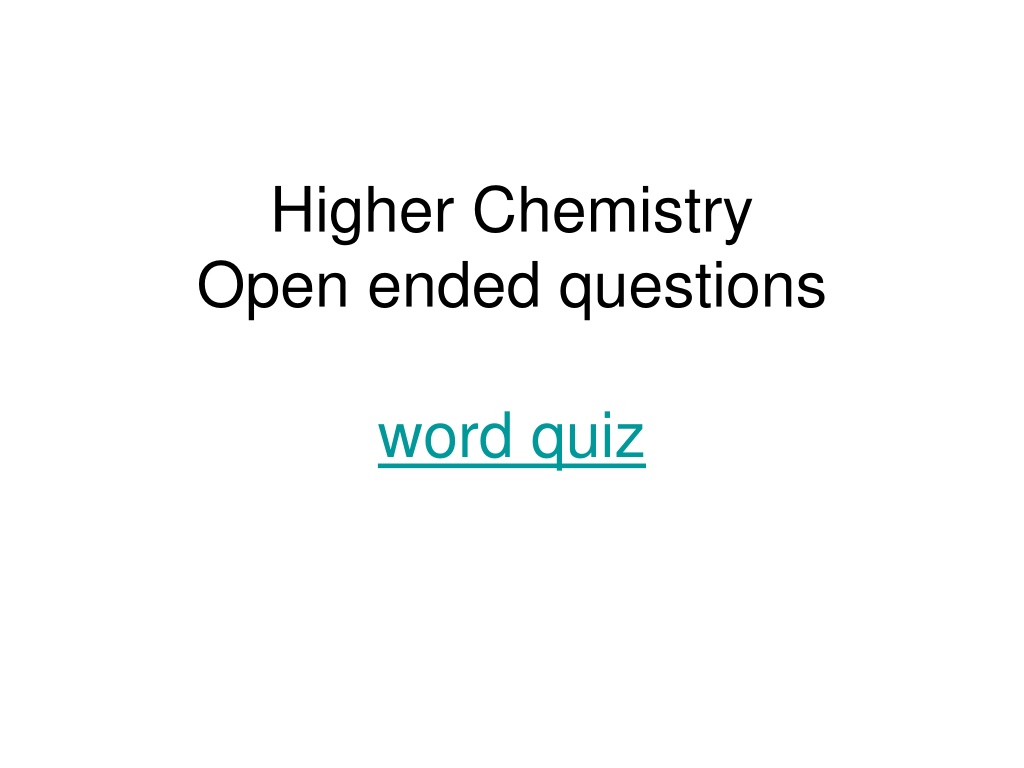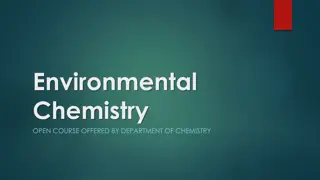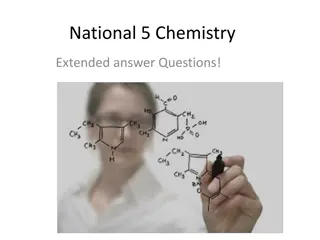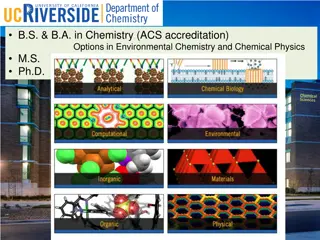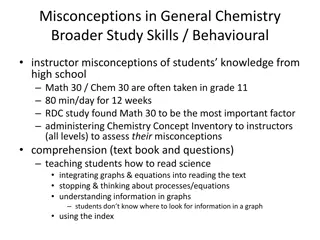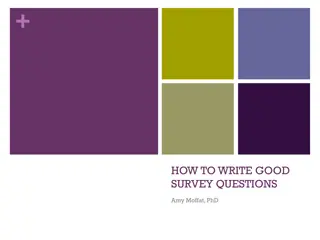Understanding Chemistry through Open-Ended Questions
The content provides a detailed assessment of student responses to open-ended chemistry questions related to hydrogen peroxide and its applications in teeth whitening gels. Various student answers are analyzed based on their understanding of the chemistry concepts involved, with explanations given for the marks awarded. Responses range from no understanding to reasonable explanations, offering insights into measuring and comparing hydrogen peroxide concentrations in gels. The criteria for marking responses are outlined, emphasizing the importance of demonstrating comprehension in chemistry problem-solving.
Download Presentation

Please find below an Image/Link to download the presentation.
The content on the website is provided AS IS for your information and personal use only. It may not be sold, licensed, or shared on other websites without obtaining consent from the author. Download presentation by click this link. If you encounter any issues during the download, it is possible that the publisher has removed the file from their server.
E N D
Presentation Transcript
Higher Chemistry Open ended questions word quiz
Marking Responses were marked according to the following criteria: The student has shown no understanding of the chemistry involved - 0 marks The student has shown a limited understanding of the chemistry involved - 1 mark The student has shown a reasonable understanding of the chemistry involved. - 2 marks The student has shown a good understanding of the chemistry Involved. - 3 marks
Hydrogen peroxide is used in gels to whiten teeth. The ion-electron equation for the oxidation of hydrogen peroxide is shown below. H2O2 O2+ 2H++ 2e Using your knowledge of chemistry, comment on possible methods for measuring and comparing the concentration of hydrogen peroxide present in two different gels.
Student 1 0 marks awarded because the student has shown no understanding of the chemistry involved. The student merely restates the chemistry given in the question.
Student 2 Although limited understanding is shown, the student has recognised that H2O2 will react to produce H+ ions in the solution. By suggesting measuring the pH, the student has suggested an indirect method of measuring the concentration of peroxide. This response is awarded 1 mark.
Student 3 A full explanation of the procedure has not been provided, but the student has recognised that the oxygen being given off would produce froth , which could be quantified. This shows limited understanding and is enough to warrant 1 mark.
Student 4 This answer gains 2 marks since the student has interpreted the ion electron equation to correctly predict the products of the electrolysis of H2O2. He/she has also proposed appropriate apparatus to use for the experiment, including the selection of carbon as a relatively inert electrode for the discharge of hydrogen. Furthermore, the student has correctly provided a method for measuring the average rate at which hydrogen is produced by the electrolysis process. The rate of electrolysis will be directly proportional to the current used, as selected by the variable resistor shown, and will be independent of the concentration of hydrogen peroxide. Although he/she has not really answered the question, his/her response shows a reasonable understanding of chemistry, and so 2 marks are awarded.
Student 5 This answer gains 2 marks because the student has provided three methods (two of which should work well in practice) that could be used to answer the question. However, the detail is vague and the response does not explain how these methods would be used to measure or compare concentrations. The answer shows a reasonable understanding of chemistry.
Student 6 This response absolutely answers the question, and gains 3 marks. In the three methods discussed, the student has given detail and has brought in the idea that this is to compare and measure the concentration of hydrogen peroxide present. The student shows a good understanding of chemistry, and brings in areas of chemistry not provided in the question.
The Periodic Table groups together elements with similar properties. In most Periodic Tables hydrogen is placed at the top of Group 1, but in some it is placed at the top of Group 7. Using your knowledge of chemistry, comment on the reasons for hydrogen being placed above either Group 1 or Group 7.
Student 1 Although the student has given two correct pieces of information regarding hydrogen, his/her answer contains no detail and therefore only shows a limited understanding. It is important to recognise that giving two pieces of information does not equate to two marks; these questions are designed to test a deep understanding of chemistry and this answer only gives the briefest response. The student gains 1 mark.
Student 2 This answer contains a lot of correct information, and the student has shown a reasonable understanding of hydrogen as an element. However, the answer lacks a more in-depth discussion of the chemistry. The student gains 2 marks.
Student 3 This answer provides ample evidence that the student has a good understanding of the chemistry of hydrogen. The answer includes information about electron arrangement, ion formation, bonding in molecular hydrogen and the reactivity of hydrogen gas, amongst other things. This student would gain 3 marks.
Rasputin, often referred to as the mad monk, was a very powerful figure in the life of Alexandra, the last Tsarina of Russia. His enemies decided to kill him using a cyanide compound. Cyanide compounds are deadly poisons. Using a bottle of potassium cyanide, they attempted to poison a cake and some wine. Rasputin ate the cake and drank the wine and yet was not harmed. Although his followers claimed this was a sign of Rasputin s supernatural powers, there are chemical explanations. Using your knowledge of chemistry and the following information, comment on possible chemical reasons why the cake and wine did not poison Rasputin. potassium cyanide + acid potassium salt + hydrogen cyanide gas (white powder) (white powder)
Student 1 The student has tried to use chemistry terms but the answer shows no understanding and, indeed, contains a lot of wrong information. The student would receive 0 marks.
Student 2 This answer contains irrelevant information, but the student has recognised that the gaseous hydrogen cyanide would escape from the mixture, and therefore Rasputin would only be eating harmless potassium salt. This shows a limited understanding, and is enough to gain 1 mark.
Student 3 The student has shown a good understanding of the chemical reaction producing potassium salt and hydrogen cyanide. He/she has given a convincing explanation as to why Rasputin may not have been poisoned by the cake or the wine, and, indeed, has also brought in a suggestion of the effect of heat in the baking of the cake. It is obvious from this answer that the student has a good understanding of chemistry, worthy of 3 marks.
CSI Miami An internet discussion board on Bad Chemistry has an entry referring to the TV drama CSI: Miami . Lastnight s episode showed the deceased victim floating in a swimming pool contaminated with sodium hydroxide. The concentration was high enough to eat through glass. When the CSI guys realised it was an alkali, they needed to neutralise it to retrieve the body, so they sent one of the team to the local grocery store for vinegar. They proceeded to pour the vinegar from four litre jugs into the pool, dropping the pH from 13 to exactly 7.0 all within a few seconds, and without any stirring! Using your knowledge of chemistry, comment on whether the events described in CSI: Miami could take place.
